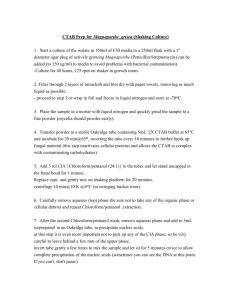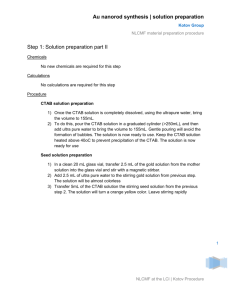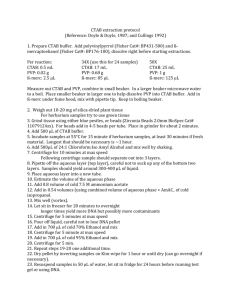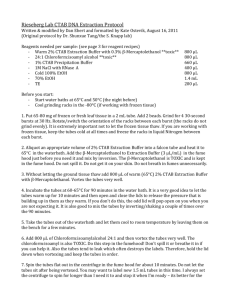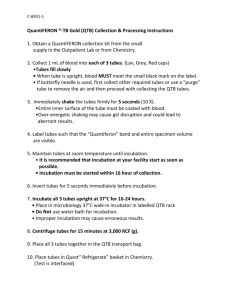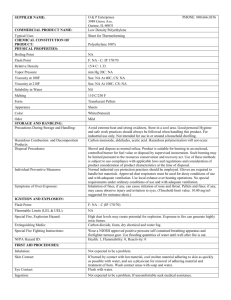Revised CTAB Plate Format flax lyophilized DNA Extractions
advertisement
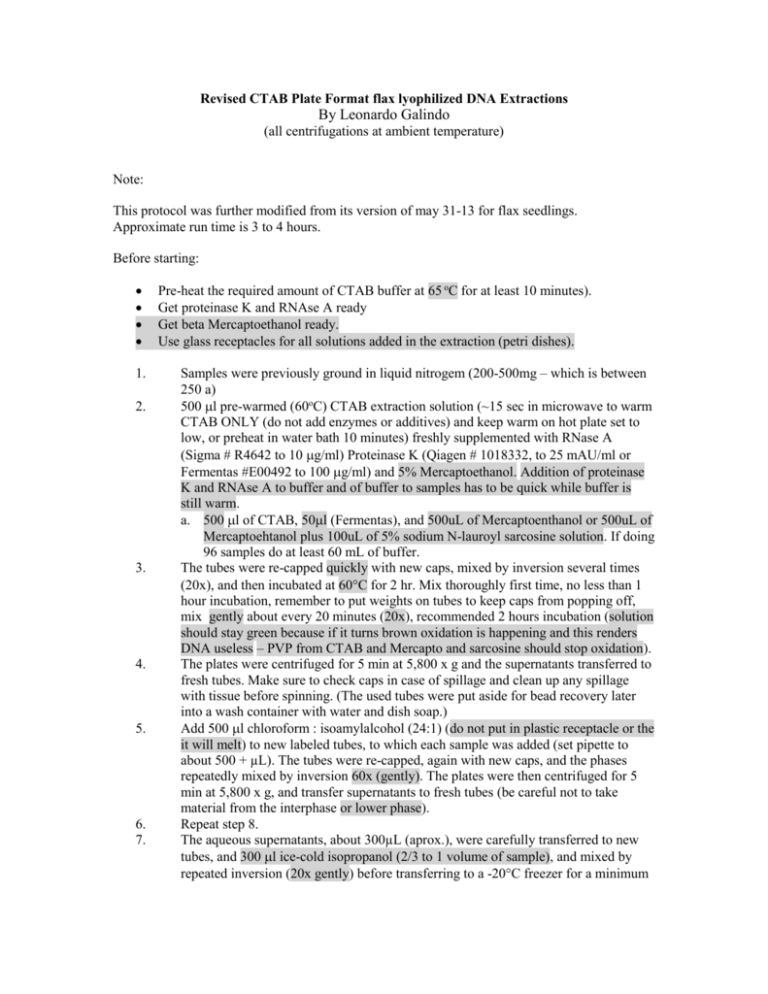
Revised CTAB Plate Format flax lyophilized DNA Extractions By Leonardo Galindo (all centrifugations at ambient temperature) Note: This protocol was further modified from its version of may 31-13 for flax seedlings. Approximate run time is 3 to 4 hours. Before starting: 1. 2. 3. 4. 5. 6. 7. Pre-heat the required amount of CTAB buffer at 65 oC for at least 10 minutes). Get proteinase K and RNAse A ready Get beta Mercaptoethanol ready. Use glass receptacles for all solutions added in the extraction (petri dishes). Samples were previously ground in liquid nitrogem (200-500mg – which is between 250 a) 500 l pre-warmed (60oC) CTAB extraction solution (~15 sec in microwave to warm CTAB ONLY (do not add enzymes or additives) and keep warm on hot plate set to low, or preheat in water bath 10 minutes) freshly supplemented with RNase A (Sigma # R4642 to 10 g/ml) Proteinase K (Qiagen # 1018332, to 25 mAU/ml or Fermentas #E00492 to 100 g/ml) and 5% Mercaptoethanol. Addition of proteinase K and RNAse A to buffer and of buffer to samples has to be quick while buffer is still warm. a. 500 l of CTAB, 50l (Fermentas), and 500uL of Mercaptoenthanol or 500uL of Mercaptoehtanol plus 100uL of 5% sodium N-lauroyl sarcosine solution. If doing 96 samples do at least 60 mL of buffer. The tubes were re-capped quickly with new caps, mixed by inversion several times (20x), and then incubated at 60C for 2 hr. Mix thoroughly first time, no less than 1 hour incubation, remember to put weights on tubes to keep caps from popping off, mix gently about every 20 minutes (20x), recommended 2 hours incubation (solution should stay green because if it turns brown oxidation is happening and this renders DNA useless – PVP from CTAB and Mercapto and sarcosine should stop oxidation). The plates were centrifuged for 5 min at 5,800 x g and the supernatants transferred to fresh tubes. Make sure to check caps in case of spillage and clean up any spillage with tissue before spinning. (The used tubes were put aside for bead recovery later into a wash container with water and dish soap.) Add 500 l chloroform : isoamylalcohol (24:1) (do not put in plastic receptacle or the it will melt) to new labeled tubes, to which each sample was added (set pipette to about 500 + µL). The tubes were re-capped, again with new caps, and the phases repeatedly mixed by inversion 60x (gently). The plates were then centrifuged for 5 min at 5,800 x g, and transfer supernatants to fresh tubes (be careful not to take material from the interphase or lower phase). Repeat step 8. The aqueous supernatants, about 300µL (aprox.), were carefully transferred to new tubes, and 300 l ice-cold isopropanol (2/3 to 1 volume of sample), and mixed by repeated inversion (20x gently) before transferring to a -20C freezer for a minimum 8. 9. 10. 11. of 2 hr. This was followed by centrifugation at 5,800 x g for 15 min. Some samples may turn pinkish here (its ok!) and a white interphase representing DNA may appear. The supernatants were carefully decanted to waste (watch this step since pellets can be lose, so a pipette could be used to get rid of extra isopropanol – pellets should be white or withish but not very dark). 500 l cold 95% ethanol (v/v) was applied to each pellet and the plates were gently vortexed (about 3 times for a 5 seconds) prior to re-centrifugation at 5,800 x g for 5 min. The supernatants were again carefully decanted to waste (watch for lose pellets as in previous step), and the pellets submerged in 500 l cold 70% ethanol (v/v), revortexed gently (about 3 times and 10 seconds each), and re-centrifuged at 5,800 x g for another 5 min. Finally, the supernatants were decanted to waste (watch for lose pellets as in previous step – decant carefully and then spin samples and get rid of extra ethanol with pipette for quicker drying) and the pellets air-dried for approximately 10 to 20 minutes (can be covered with AirPore tape sheets and left overnight before rehydration) before each was thoroughly dissolved in 125 l sterile ultrapure water or TE 10:1 (or if left overnight, with autoclaved TE buffer) with gentle agitation. The fully rehydrated genomic DNAs were placed on ice, and 1.0 l (2µL) of each was characterized spectrophotometrically in a Thermo Scientific NanoDrop 2000 before they were frozen for future use. Typically, yields of 25-250 ng/l were achieved with excellent spectra and 1.8-2.0 A260/280 ratios. Reagents CTAB DNA Extraction Solution** Reagent Cetyl-tri-ammonium bromide (CTAB) Polyvinylpyrolidone (PVP-40, average MW 40,000) Tris-HCl pH 8.0 EDTA pH 8.0 NaCl Spermidine stock powder powder final 2% 2% 1M 0.5 M 2.5 M 1 M (145.2g/L) 100 mM 25 mM 1M 0.5g/L 100mL 2g 2g 10 mL 5 mL 40 mL 0.05g or 344 uL of 1 M stock **For complete dissolution heat needs to be applied on a hot plate. Watch plate while dissolving since it might boil quickly. Tris-Cl (or HCl) pH8.0 (MW 121.1) Mix 12.11g of Tris base with 70mL of milliQ water (heat might be needed for dissolution). Mix well and adjust pH with concentrated HCl (if solution is heated, allow to cool before adjusting pH). Adjust volume to 100mL and autoclave for 20 minutes. EDTA 0.5M pH8.0 (MW 372.2) Mix 18.61g of EDTA with 70mL of milliQ water. Mix well and adjust pH with NaOH pellets (EDTA will not come into solution until pH is adjusted with the NaOH – add the pellets slowly to reach desired pH). Adjust to 100mL and autoclave for 20 minutes. NaCL 2.5M (MW 58.44) Add14.6g of NaCl to 70mL of milliQ water. Mix well, adjust volume to 100mL and autoclave for 20 minutes. 5% Sodium N-lauroyl sarcosine Add 5gr of reagent to 90mL of water. Dissolve for 20 minutes (it can still be a little turbid after this). Autoclave for 20 minutes (solution becomes clear).

